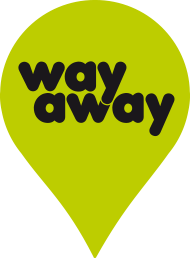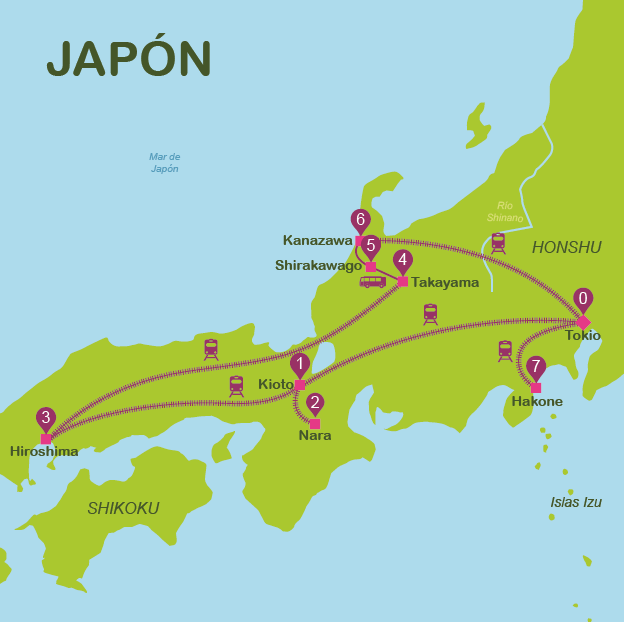How to move around in Japan:
The best way of travelling around Japan is to use its extensive railway network, which runs quickly and efficiently from city to city. Travelling on one of its bullet trains (Shinkansen) is also an experience you should not miss!
To get around in the cities, just walk and use public transport (buses and the metro). Taking taxis in large cities, especially in Tokyo, is not recommended because of its high cost.
- How to get train tickets. Is Japan Rail Pass worth it?
- How to buy the Japan Rail Pass
- How to buy tickets and reserve seats with and without Japan Rail Pass
- How to catch the bus in Japan
How to get train tickets in Japan:
Until the end of 2023, the best thing, both in terms of cost and practicality, was to buy the Japan Rail Pass (JRP from now on). This pass, valid for non-Japanese citizens who are "temporary visitors", entitles you to use most trains in addition to Tokyo's main railway lines. The problem is that at the end of 2023, Japan Rail increased the cost of these passes by almost 70%, making it really difficult get your money's worth.
Is it worth buying the Japan Rail Pass?
The price of the JRP depends on the number of days and the class ("green" for superior and "ordinary" for tourist). In round numbers, the cost of the tourist pass is about €300 for 7 days, €500 for 14 days and €600 for 21 days (see updated prices in yen).
The price of long bullet train journeys (Tokyo-Kyoto, Kyoto-Hiroshima, Hiroshima-Takayama, Takayama-Tokyo...), purchased individually, is around €80-100 per journey, and short train journeys by normal or express trains (Tokyo-Nikko, Tokyo-Hakone...) about €25, so you will have to make more than 5 long journeys to pay off the 14-day pass or more than 3 long journeys to pay off the 7-day pass. Which is complicated. You can use this website to see the different routes and the cost purchased individually.
Is it worth buying the JRP to follow the Way Away routes?
If your international flight arrives in Osaka and leaves from Tokyo, do not buy the JRP, it won't pay it off.
If your flight enters and leaves through the same city (Osaka or Tokyo) then it may pay off in some cases:
- For the 14-day route it is worth buying the 14-day JRP. It's not that you are going to save a lot of money, but it is convenient and allows you to book train tickets from home.
- You can also buy the 14-day JRP for the 15-day route, although you must activate it on the first day if you enter and leave the country through Tokyo, and on the second day if you do it through Osaka (this way the last journey from Tokyo to Osaka is covered, which is more expensive).
- For the 12, 11 and 10 day routes you can buy the 7-day JRP if you enter through Tokyo, and activate it on day 1 (if you enter through Osaka it is not worth it).
- For routes of 13, 9, 8 and 7 days, the JRP does not compensate in any of the cases (it will be much cheaper to buy the tickets separately).
How to buy the Japan Railpass:
You must purchase the Japan Rail Pass "exchange order" in your home country 1 month before arrival. Once you arrive in Japan, you must exchange this order for the paper JRP at a Japan Rail (JR) office. On the Route we will tell you where to do it on the first day.
You can purchase this "exchange order" on the official JRP website, on other authorized websites or by going in person to the agencies indicated here. We recommend you do it on the official website. The price is the same as the others and you can also book the seats for the journeys directly on their website. When you arrive in Japan, you can collect the JRP by showing your passport and they will also give you the tickets for the trains on which you have reserved a seat.
To buy it on the official page, go to this page, click on "Create a New Account" and follow the steps indicated until you verify your account. Then "Log In" and press "Purchase a Japan Railpass". You will have to indicate the date of arrival, number of days, arrival airport, number of people (adults and children). On the next screen, insert the data of each traveler (note that the credit card with which you pay must be in the name of the main traveler). Once the purchase is confirmed, it will take you to the payment page for you to enter the card details.
How to buy tickets and reserve seats on Japan trains:
Most trains have carriages with "non-reserved" seats, where you can get on by simply showing your JRP or ticket at the entrance. But we recommend you make a reservation to avoid problems if the train is full and, above all, for those trains that require reservations in all their carriages (e.g. Narita Express). It is especially important to reserve a seat on the most conflictive dates, such as April 27 to May 6, August 11 to 20 and December 28 to January 6.
You can change the ticket as many times as you want at no cost, so there is no problem in booking them in advance. On our Route, we will tell you whether or not you should reserve your seat depending on the train and jorney.
If have purchased the JRP on another website, once you arrive in Japan you will have to go to a Reservations Office or Travel Services Center, tell them which ticket you want to reserve and show them the JRP. There they will give you physical tickets with reserved seats. You can also do it at any ticket office and at any time during the trip. ATTENTION: We recommend that on the first day of arrival you make a reservation for all the tickets that we indicate along the Smart Route. In these offices they often do not speak English, so we recommend looking for all the tickets you will need on this website. Print them before you travel so you can show them to the ticket agent. In the details of each day, we will notify you when you will have to take a train so that you can print the schedule.
If you travel without Japan RailPass, there are routes that you can buy or reserve online up to 3 months before traveling. The best website we have found and tested is Klook. The price is practically the same as at the box office but with the convenience of being able to reserve the ticket in advance. In some cases they will give you a ticket on your mobile phone and other times they will give you a code that you will have to exchange for a physical ticket at the ticket office. For the rest of the routes (which are not available on Klook) you can buy them at the ticket office. We recommend that you look for the route and time you want on this website, and take the details printed or on your mobile phone to show it at the ticket office (in the trip planner we will show you the best way to buy it for each route).
How to take the trains in Japan:
If you have JRP, you must pass the JRP card through the automatic door. If you have a reserved seat and therefore a ticket, you have to pass both. Be careful that you cannot go through the turnstiles that say IC Card Only. If the station does not have automatic doors, then go through the door with a guard and show him the JRP and/or ticket.
If you don't have JRP, pass the ticket through the automatic door.
How to catch the bus in Japan:
Although both trains and the metro operate very similarly to those in Europe, the buses are different!
- Get on through the back door (unless the bus only has one).
- When you board, take a ticket from the dispensing machine. The ticket features a printed number that is used to calculate the eventual price of the ride.
- A screen above the driver indicates the next stop and the different fares for this stop, depending on where you got on the bus. Calculate your fare by comparing the number printed on the ticket with that on the screen.
- Use the button on the wall to request the stop when you approach it.
- When you get off through the front door, leave the ticket and the exact fare in the tray beside the driver.
- If you do not have the exact change, there are change machines on the bus.
Exception: Tokyo metropolitan buses. Get on the bus at the front and get off at the back. A fixed fare is paid upon boarding (although this is not a means of transport we recommend for Tokyo).

